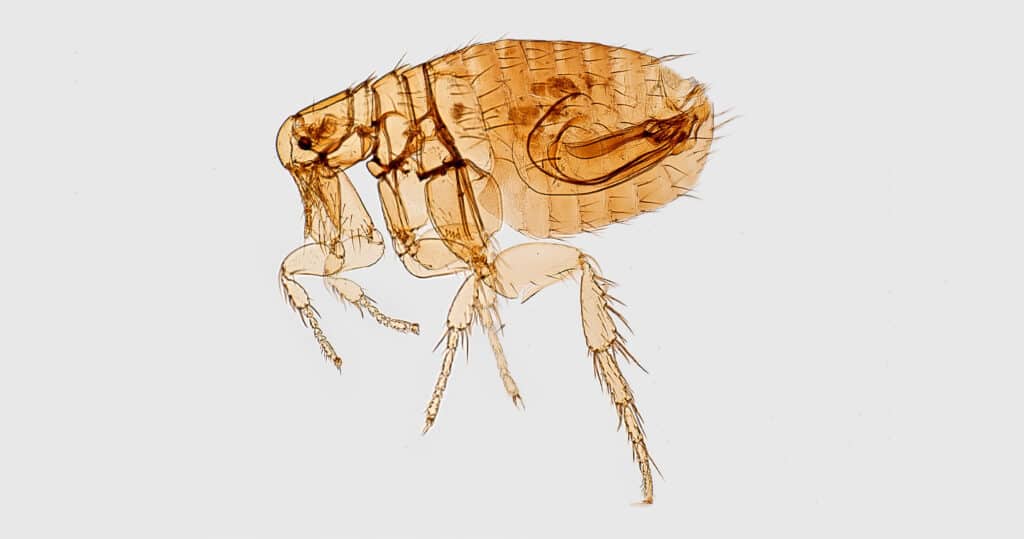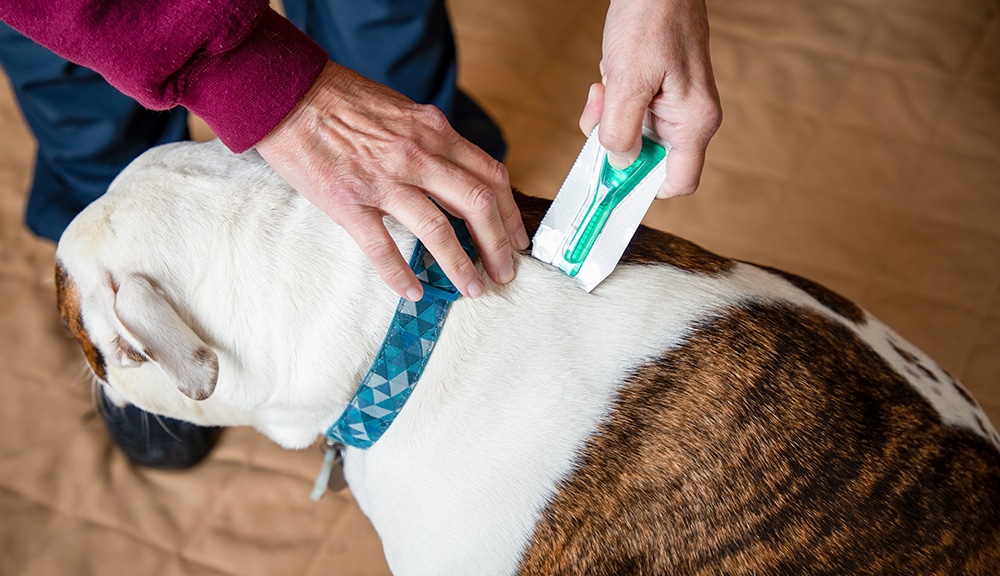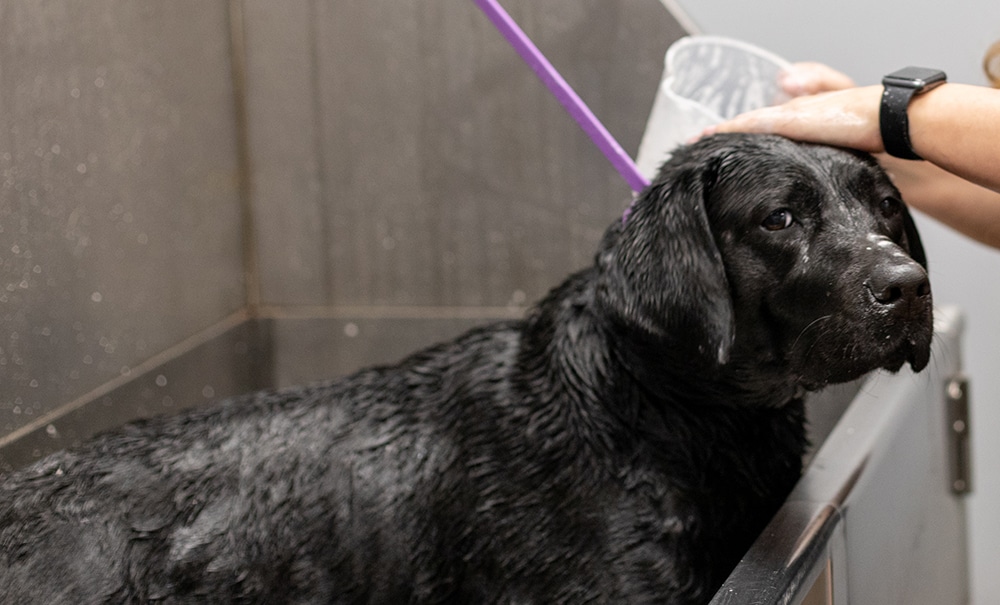Fleas, ticks and mosquitoes are summer’s nasty little buggers. These tiny insects may seem harmless at first glance, but they can cause chaos to your beloved pet and to your home. Thankfully, there are numerous ways to protect your canines and felines through flea, tick and heartworm prevention.
This blog will cover the dangers fleas, ticks and mosquitoes pose for dogs and cats along with a variety of preventative measures to keep them at bay. We’ll also give tips for removing ticks from your pet.
How Fleas and Ticks Affect Dogs
Both fleas and ticks are external parasites. They can create skin irritation through their bites and can cause anemia by how much blood they take. If you notice the signs of excessive licking or scratching, hot spots, loss of appetite, low energy, fever or swollen lymph nodes and/or joints, call your vet immediately.
Fleas
Fleas feed on your pet’s blood while they snuggle into the nice, soft, warm fur. These parasites can be found anywhere throughout your dog or cat’s coat. They spread droppings and eggs in the fur, which appear as dark and/or white specks.

Ticks
Ticks attach near the head, neck, ears, eyes or paws of dogs and cats. They bury themselves partially under the skin and become engorged.
The ticks to watch out for are the brown dog tick (kennel tick) which can transmit Ehrlichiosis, the deer tick which can transfer Lyme disease, and the American dog tick (the most common tick) which can spread Rocky Mountain spotted fever.

How Mosquitoes Affect Dogs
Mosquitoes are not external parasites, but they are carriers of a parasitic worm called Dirofilario immitis (more commonly known as heartworm). The worms are transmitted through the mosquito’s bite. Heartworm in dogs and cats can result in severe lung disease, heart failure, other organ damage and even death if not treated.

Flea, Tick and Heartworm Prevention Options for Dogs
The best defense against fleas, ticks and heartworms is consistent protection in the form of oral medications, topical medications or flea collars. There are lots of options for oral or topical medications, however, it is best to discuss with your veterinarian which one is best for your dog.
Deciding between oral and topical will depend on your pet’s medical history, how often they are in water, if you want to repel fleas and/or ticks, the area where you live, if your pet is pregnant or nursing, etc.
Many pet owners wrongfully assume that flea and tick preventative measures completely deter fleas and ticks. Even with flea, tick and heartworm medications, parasites may still be attracted to your pet. The goal of the medications is to prevent infections and the transmission of diseases if the parasites do come into contact with your dog or cat.
Oral Flea, Tick or Heartworm Medication
Oral preventative medications tend to last longer than topical preventative medications and can come in the form of pills or chews. These medications must be prescribed by your veterinarian and cannot be purchased over the counter.
Unfortunately, parasites will still attempt to attach to pets who use oral preventative medications. Since the preventative medication is in the pet’s bloodstream, fleas and ticks first need to bite your pet in order for the medication to be effective. This paralyzes and kills the parasites, and protects your pet from the transmission of diseases.
Heartworm medication is only available in a pill or chew form and is not available in topical form.

Topical Flea and Tick Medication
Topical flea and tick medications come in liquid form. Prescriptions are available from veterinarians, though most topical medications are available over the counter.
Topical preventative medications do not cross the skin barrier or enter into the bloodstream, so your dog doesn’t need to be bit in order for the medication to take effect. With the medication sitting on the skin, any flea, tick or mosquito that comes in contact with it will die or retreat.
Read the product instructions to learn how often you should reapply topical treatments for your pet. While many treatments are waterproof, they still wash away over time and lose their effectiveness. Pay attention as well to other instructions, like whether or not it’s okay to wash your pet shortly before or after applying.
Topical medications can be oily and cause skin irritations for your pet. Always ensure you follow directions on the packaging and utilize the proper amount of medication for your pet. If you notice any adverse reactions to the medication, contact your veterinarian for guidance.

Flea and Tick Collars
Unlike topical and oral medications, flea and tick collars actually help to repel parasites. The collars release and spread chemicals along your pet’s fur and skin which then kills fleas and ticks that come into contact with your pet.
Traditionally, flea collars have been seen as the perfect option for small dogs since they are cost effective, long lasting and easy to use.
There is some controversy on flea collars, however, due to the recent discovery of the potentially harmful chemical TCVP present in many dog flea collars. This chemical is not only dangerous for dogs, but also for humans as well. We recommend consumers check product labels before purchasing and avoid the many collars containing TCVP. If you have questions or concerns, consult your vet.

Natural Options for Flea and Tick Prevention for Dogs
If you wish to avoid all chemicals and prefer a more holistic approach, essential oils can be used to deter fleas, ticks and mosquitoes. Citronella, eucalyptus, peppermint, lemon grass, tea tree, rosemary or rose geranium are all good options for dogs.
Never put essential oils directly onto your dog’s skin. Instead dilute with water in a spray bottle, mix it with shampoo when you give them a bath, or even create your own herbal flea and tick collar.
If you have never used essential oils on your pet before, you may wish to apply diluted essential oils to a test spot first and monitor your pet to make sure they have no allergic reactions.

Maintaining Your Dog’s Environment
Keeping your dog’s environment clean and tidy is crucial to lowering their chances of coming in contact with one of these critters and preventing them from taking over your home. Mow your lawn to a shorter cut, keep shrubs contained and drain any standing water near your home.
Regular cleaning indoors also helps. It’s a good idea to wash your dog’s bed with soap and hot water and vacuum carpets and curtains weekly if not daily.

Specialty Shampoos for Fleas and Ticks
Having your dog on a consistent grooming schedule is very important, especially when it comes to bathing your pet. Lathering your pet with normal pet-friendly shampoo and water will not kill fleas, however. Find a shampoo specifically designed for killing fleas and ticks. Ask your local pet groomer for suggestions on flea and tick shampoos.
If a pet has fleas, utilizing specialty shampoo will help. Let the shampoo sit 5-10 minutes so the product has time to penetrate and kill the fleas. Be aware, however, that this is not guaranteed to kill all of the fleas. Fleas are very resilient!
Comb out your dog’s hair thoroughly after the specialty flea bath. Use a flea comb for extra caution to make sure any fleas are down the drain and not still hitchhiking on your dog’s back.

Tick Removal
It’s crucial to inspect your dogs after walks, particularly in wooded areas. If you find a tick, you should physically remove it as soon as possible.
Make sure that you can see the head before attempting to remove the tick. If the tick’s head is buried too far into your pet’s skin, it’s best to ask a veterinarian to remove the tick. If you attempt to remove a tick but fail to remove the head, seek the care of a veterinarian for assistance.
For a safe removal use clean and pointed tweezers. Grasp the tick as close to your dog’s skin as you can without pinching their skin. Then, once you have a good grip on the tick, slowly in a steady fashion pull the tick straight out. Afterwards, dab disinfectant or antiseptic cream on the spot and give your good girl or boy a much deserved treat.
A Tick key is another useful tool for removing ticks from dogs and cats. It utilizes forward leverage to remove the entire tick quickly and safely without squishing it.

Flea and Tick Prevention for Cats
Your feline friend is also at risk for fleas and ticks, even if they’re a strictly indoor cat. Like dogs, cats can benefit from preventative oral, topical or collar treatments.
Dog products should not be used on cats since some of the chemicals used like permethrin and pyrethrin are highly toxic to cats. This is important to remember when you have dogs and cats in the same household. Your canine’s topical medication must be cat safe. Consult your vet on which topical medications are best if you decide to go with that option.
Even for the natural approach, caution is encouraged when treating cats. There are certain essential oils that are toxic to them like tea tree and eucalyptus. Citronella, peppermint and lemongrass are okay. However, small doses are preferred, as cats tend to lick and groom more often than dogs. If too much of an essential oil is digested by a cat, it can cause foaming at the mouth, wobbliness and even liver problems.

Summary
Fleas, ticks and mosquitoes are not just a nuisance but can also bring serious harm to your pet. As a responsible pet owner, it’s important to stay current with preventative measures and regular checks for both dogs and cats to ensure your pet is safe and has low chances of contracting diseases from parasites.
Get in the habit of checking your pet over for unwanted parasitic hitchhikers after time outdoors. Maintain your environment to keep areas tidy and clean. Keep with a regular grooming regimen to evict the critters who latch onto your pet despite your best efforts.
If you have questions regarding the various preventative options for your pet, please contact your veterinarian for guidance.
Want to learn more? PetCareRx has some great information in this blog about specific heartworm, flea and tick prevention medicines.


